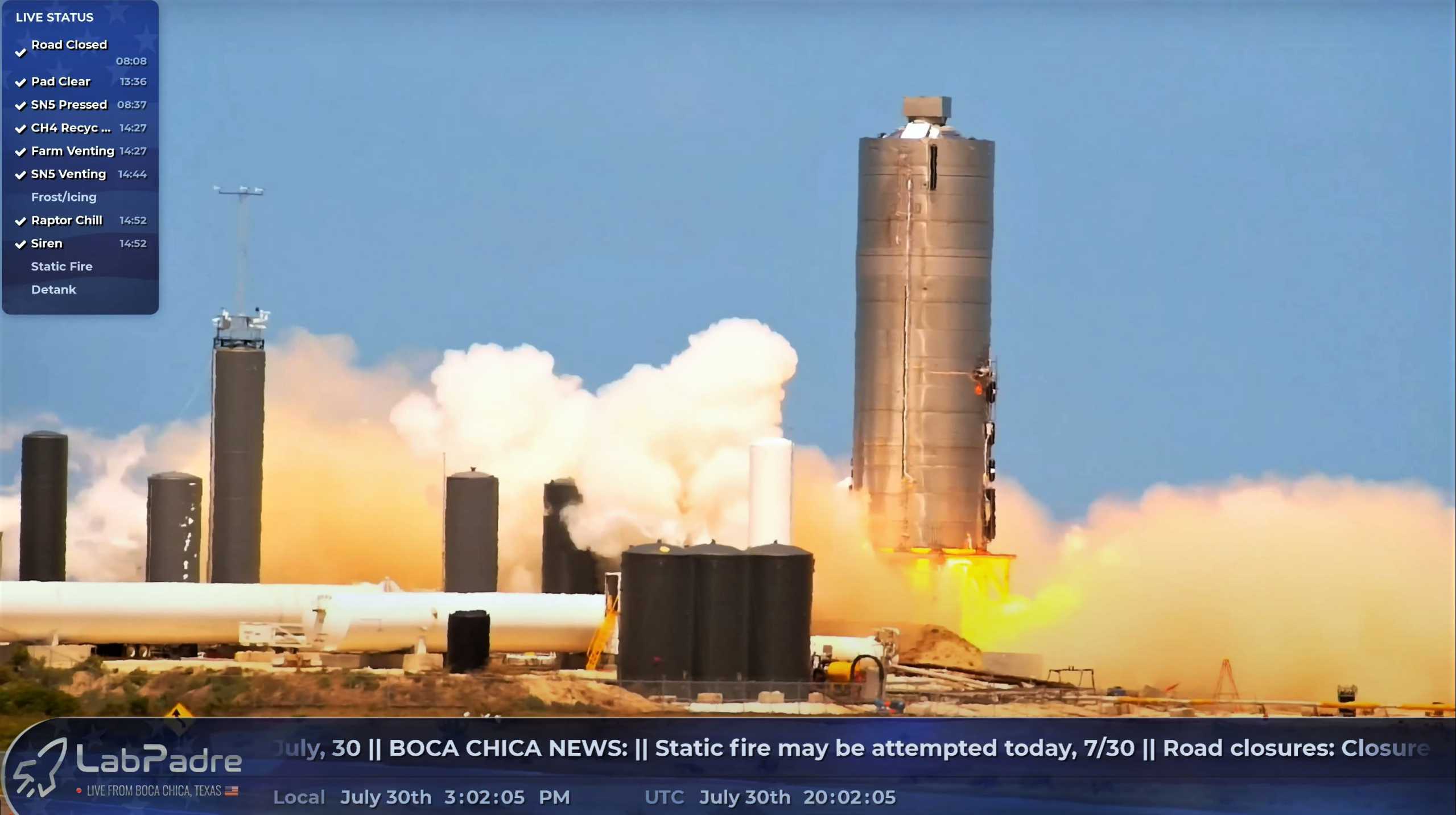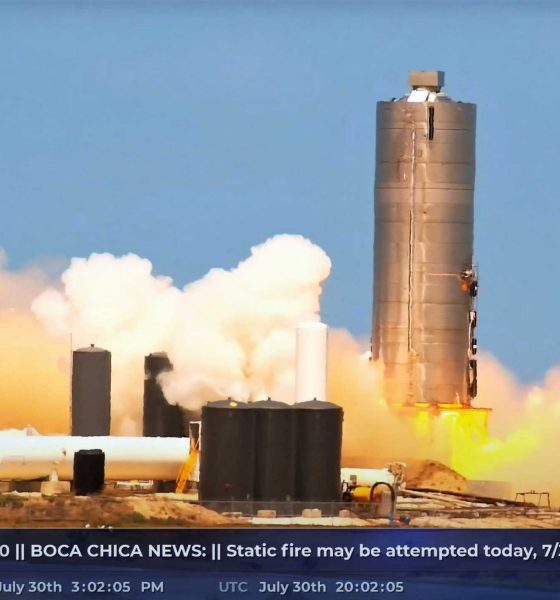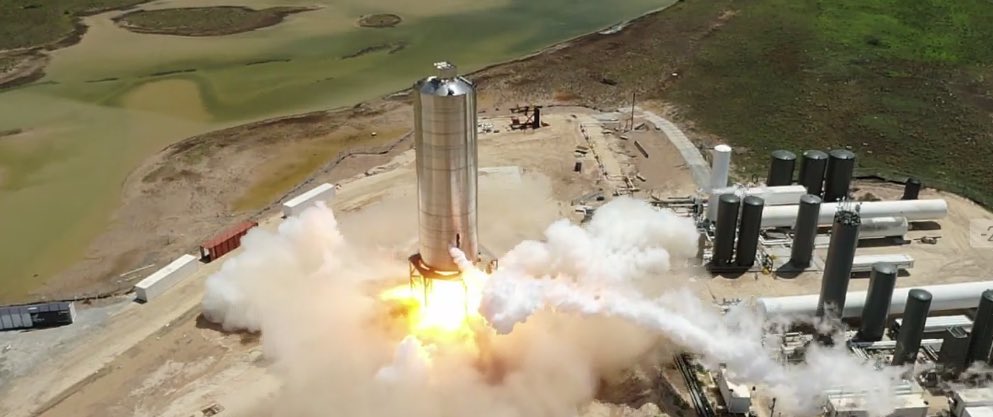

News
SpaceX Starship static fire success sets rocket up for hop debut
At long last, SpaceX’s fifth Starship prototype has successfully ignited its lone Raptor engine in a test known as a static fire, paving the way for the first flight of a full-scale Starship as early as this weekend.
After almost three weeks of delays and several aborted attempts, SpaceX managed to fix a variety of relatively minor hardware bugs described by CEO Elon Musk on July 28th. The first static fire attempt was originally scheduled as early as July 10th and wound up gradually slipping a few days at a time to July 25th. Thus began another series of delays after static fire attempts – with varying progress from each – were aborted on July 25th, 27th (x2), and the morning of the 30th.
Thankfully, though those aborts and scrubs and delays have finally come to an end – at least for the moment. If things go according to plan over the next several days and teams are able to rectify a critical issue discovered earlier this week, Starship SN5 could become the first full-scale of its kind to lift off (intentionally) just a few days from now.

Prior to Starship SN5’s successful July 30th static fire, Musk revealed in a tweet that the rocket’s second attempt was aborted on July 27th after Hurricane Hanna damaged a connector, presumably related to telemetry and control. SpaceX fixed the issue and managed to stretch its test window by a few hours, allowing for a second attempt later that night.
Unfortunately, Starship’s static fire was scrubbed again by what Musk later described as a crucial fuel valve that failed to open, as well as “some odd [behavior]” observed in a pump related to the Raptor engine’s steering hardware. To complete the static fire as SpaceX later would two days later, the finicky “fuel spin pump” would have to have been fully fixed, but Raptor’s thrust vector control (TVC) pump issues could have plausibly been put off.
Given that SpaceX spent approximately 2.5 days inspecting and repairing Starship after the third static fire abort, it’s likely that they had time to fix whatever bugs were plaguing Raptor’s TVC hydraulic system. Regardless, Raptor’s TVC will need to be operating flawlessly before SpaceX goes ahead with the first full-scale Starship flight test. The 150m (~500 ft) hop will be the first time a Starship prototype roughly the same size – and built out of the same materials – as an orbital-class ship will attempt controlled flight.
Prior to July 30th’s static fire, SpaceX had already filed a few temporary flight restrictions (TFRs) – used to warn aviators of keep-out zones – with the FAA for hop test attempts on August 2nd and 3rd. SpaceX will likely need 12-24 hours to analyze the data, inspect Starship, and determine a timeline for the first hop attempt, but there is at least a slight chance that the company will push for Starship SN5 to fly as early as this Sunday. Stay tuned as things play out and the hop test gets a more concrete date.
Check out Teslarati’s Marketplace! We offer Tesla accessories, including for the Tesla Cybertruck and Tesla Model 3.

News
Tesla FSD fleet is nearing 7 billion total miles, including 2.5 billion city miles
As can be seen on Tesla’s official FSD webpage, vehicles equipped with the system have now navigated over 6.99 billion miles.

Tesla’s Full Self-Driving (Supervised) fleet is closing in on almost 7 billion total miles driven, as per data posted by the company on its official FSD webpage.
These figures hint at the massive scale of data fueling Tesla’s rapid FSD improvements, which have been quite notable as of late.
FSD mileage milestones
As can be seen on Tesla’s official FSD webpage, vehicles equipped with the system have now navigated over 6.99 billion miles. Tesla owner and avid FSD tester Whole Mars Catalog also shared a screenshot indicating that from the nearly 7 billion miles traveled by the FSD fleet, more than 2.5 billion miles were driven inside cities.
City miles are particularly valuable for complex urban scenarios like unprotected turns, pedestrian interactions, and traffic lights. This is also the difference-maker for FSD, as only complex solutions, such as Waymo’s self-driving taxis, operate similarly on inner-city streets. And even then, incidents such as the San Francisco blackouts have proven challenging for sensor-rich vehicles like Waymos.
Tesla’s data edge
Tesla has a number of advantages in the autonomous vehicle sector, one of which is the size of its fleet and the number of vehicles training FSD on real-world roads. Tesla’s nearly 7 billion FSD miles then allow the company to roll out updates that make its vehicles behave like they are being driven by experienced drivers, even if they are operating on their own.
So notable are Tesla’s improvements to FSD that NVIDIA Director of Robotics Jim Fan, after experiencing FSD v14, noted that the system is the first AI that passes what he described as a “Physical Turing Test.”
“Despite knowing exactly how robot learning works, I still find it magical watching the steering wheel turn by itself. First it feels surreal, next it becomes routine. Then, like the smartphone, taking it away actively hurts. This is how humanity gets rewired and glued to god-like technologies,” Fan wrote in a post on X.
News
Tesla starts showing how FSD will change lives in Europe
Local officials tested the system on narrow country roads and were impressed by FSD’s smooth, human-like driving, with some calling the service a game-changer for everyday life in areas that are far from urban centers.

Tesla has launched Europe’s first public shuttle service using Full Self-Driving (Supervised) in the rural Eifelkreis Bitburg-Prüm region of Germany, demonstrating how the technology can restore independence and mobility for people who struggle with limited transport options.
Local officials tested the system on narrow country roads and were impressed by FSD’s smooth, human-like driving, with some calling the service a game-changer for everyday life in areas that are far from urban centers.
Officials see real impact on rural residents
Arzfeld Mayor Johannes Kuhl and District Administrator Andreas Kruppert personally tested the Tesla shuttle service. This allowed them to see just how well FSD navigated winding lanes and rural roads confidently. Kruppert said, “Autonomous driving sounds like science fiction to many, but we simply see here that it works totally well in rural regions too.” Kuhl, for his part, also noted that FSD “feels like a very experienced driver.”
The pilot complements the area’s “Citizen Bus” program, which provides on-demand rides for elderly residents who can no longer drive themselves. Tesla Europe shared a video of a demonstration of the service, highlighting how FSD gives people their freedom back, even in places where public transport is not as prevalent.
What the Ministry for Economic Affairs and Transport says
Rhineland-Palatinate’s Minister Daniela Schmitt supported the project, praising the collaboration that made this “first of its kind in Europe” possible. As per the ministry, the rural rollout for the service shows FSD’s potential beyond major cities, and it delivers tangible benefits like grocery runs, doctor visits, and social connections for isolated residents.
“Reliable and flexible mobility is especially vital in rural areas. With the launch of a shuttle service using self-driving vehicles (FSD supervised) by Tesla in the Eifelkreis Bitburg-Prüm, an innovative pilot project is now getting underway that complements local community bus services. It is the first project of its kind in Europe.
“The result is a real gain for rural mobility: greater accessibility, more flexibility and tangible benefits for everyday life. A strong signal for innovation, cooperation and future-oriented mobility beyond urban centers,” the ministry wrote in a LinkedIn post.
News
Tesla China quietly posts Robotaxi-related job listing
Tesla China is currently seeking a Low Voltage Electrical Engineer to work on circuit board design for the company’s autonomous vehicles.

Tesla has posted a new job listing in Shanghai explicitly tied to its Robotaxi program, fueling speculation that the company is preparing to launch its dedicated autonomous ride-hailing service in China.
As noted in the listing, Tesla China is currently seeking a Low Voltage Electrical Engineer to work on circuit board design for the company’s autonomous vehicles.
Robotaxi-specific role
The listing, which was shared on social media platform X by industry watcher @tslaming, suggested that Tesla China is looking to fill the role urgently. The job listing itself specifically mentions that the person hired for the role will be working on the Low Voltage Hardware team, which would design the circuit boards that would serve as the nervous system of the Robotaxi.
Key tasks for the role, as indicated in the job listing, include collaboration with PCB layout, firmware, mechanical, program management, and validation teams, among other responsibilities. The role is based in Shanghai.
China Robotaxi launch
China represents a massive potential market for robotaxis, with its dense urban centers and supportive policies in select cities. Tesla has limited permission to roll out FSD in the country, though despite this, its vehicles have been hailed as among the best in the market when it comes to autonomous features. So far, at least, it appears that China supports Tesla’s FSD and Robotaxi rollout.
This was hinted at in November, when Tesla brought the Cybercab to the 8th China International Import Expo (CIIE) in Shanghai, marking the first time that the autonomous two-seater was brought to the Asia-Pacific region. The vehicle, despite not having a release date in China, received a significant amount of interest among the event’s attendees.








